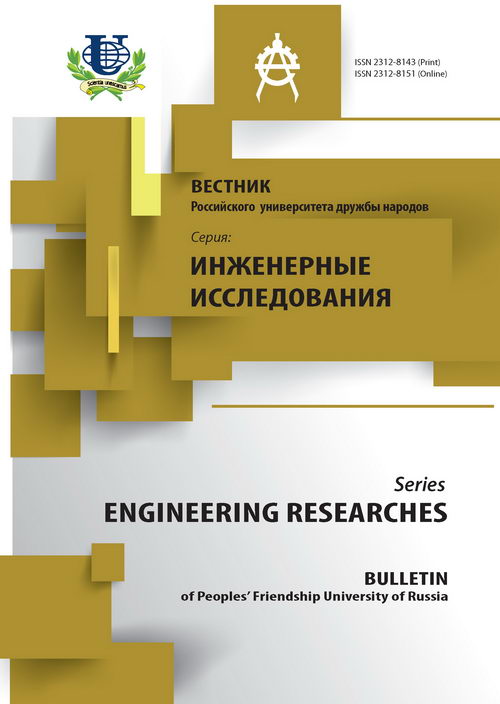No 1 (2009)
- Year: 2009
- Articles: 16
- URL: https://journals.rudn.ru/engineering-researches/issue/view/341
Articles
Mechanism of biosphere homeostasis as a cause of great glaciations, mass extinction, and periodicity of sedimentation and ore accumulation
Abstract
Self-oscillatory mechanism of biosphere homeostasis is substantiated by periodic alteration of water stratification by the salinity of the warm ocean to that by the temperature of the cold ocean and vice versa. These passes originate rhythmic cascades in inter-ocean currents and lead to global changes.
RUDN Journal of Engineering Research. 2009;(1):5-10
 5-10
5-10


 11-16
11-16


New data on mineralogy of volcanic-hosted massive sulfide deposits in the Urals
Abstract
The study of mode of occurrence of Au, Ag, Bi, Se and Te covers a row of giant VMS deposits of the Urals (Uralian or Cu-Zn-pyritic type): nondeformed Safyanovsk, altered by late hydrothermal processes Uzelginsk, intensively deformed Gay and Uchaly and a few small polymetallic and Cu-Co deposits.
RUDN Journal of Engineering Research. 2009;(1):17-22
 17-22
17-22


Big Pb-Zn deposits in Macedonia
Abstract
The analysis of mineral parageneses, ore textures and structures, stable isotopes in minerals provided a base for understanding of mineralization processes in two big metasomatic Pb-Zn deposits Sasa and Toranica located in the same structural-metallogenic zone of SMM.
RUDN Journal of Engineering Research. 2009;(1):23-29
 23-29
23-29


Geochemical prospecting of endogenic gold deposits
Abstract
Rational complex of prospecting methods for endogenic gold deposits which are of different scale and significance is studied and distinguished. Prospecting aims and tasks at the geological and explorations legs as far as methods of geochemical investigations are offered. Special attention is pied to anomalies finding out and appreciation of its ore formation and economic value.
RUDN Journal of Engineering Research. 2009;(1):30-36
 30-36
30-36


Relief of island Sri Lanka (south-western part) and placers
Abstract
On the explored territory 5 genetic types of the relief are distinguished as well as related to them gem sands. These gem sands had been formed in the Kalu-Ganga river valley within the junction zone of the low accumulative plain-depression and low hill and low mountain ridge relief made up by the productive Proterozoic thick layers.
RUDN Journal of Engineering Research. 2009;(1):37-42
 37-42
37-42


Geology and secondary dissemination aureoles of the north part of Mikheevskoe copper-porphyric deposit
Abstract
The article is devoted to discussion of mineral composition of ore and mineral sequence. We learned secondary dissemination aureoles of Mikheevskoe deposit. And contrast secondary aureoles of Cu, Zn, Pb, Ag, I, Mo, Fe were traced above the north part of deposit. It's spatial position is typical for copper-porphyric deposits.
RUDN Journal of Engineering Research. 2009;(1):43-47
 43-47
43-47


Geological position and composition of Au-Ag ores of Central Chukotka
Abstract
The Upper Yablon and Penzhina-Anadyr metallogenic zones lie within the Central sector of the Okhotsk-Chukchi volcanogenic belt. These zones are made of Cretaceous volcanic covers and bodies of comagmatic subvolcanic and extrusive varieties. Volcano-tectonic structures define positions of ore clusters (trends) bearing Au-Ag mineralization. Argentiferous sulfosalts and fahlerz are most typical of ore-bearing veins and veinlet zones of the Upper Yablon zone, whereas acanthite prevails among the ore minerals in the Penzhina-Anadyr zone.
RUDN Journal of Engineering Research. 2009;(1):48-52
 48-52
48-52


Oil and gas potential of area of water Northern Caspian
Abstract
At the beginning of current century the new large North-Caspian oil-gas bearing area was opened in Russian sector Caspian. Pools oils and gas are contained in Deposits of Middle and Upper Jurassic, Lower Cretaceous and Paleogene. The storey of oil and gas Potential - 2700 m. Based on discovered Fields new large region oil and Gas Production is formed in Russia.
RUDN Journal of Engineering Research. 2009;(1):53-58
 53-58
53-58


 59-65
59-65


 66-70
66-70


Stable associations of magmatic rocks (problems of isolation and classification)
Abstract
Study and systematization of magmatic rocks combinations (volcanic series, magmatic complexes, formations, associations) is one of the paramount tasks in petrology. The decision of this task opens opportunities for detection of some new petrological regularities. The distinguishing of magmatic associations which steadily recur in space (elementary or stable associations) allowed to show the existing in the Nature some petrological groups of such associations. These groups differ between themselves by petrochemical trends.
RUDN Journal of Engineering Research. 2009;(1):71-76
 71-76
71-76


Litological, petrographic and mineralogical peculiarities of series containing Au-ore deposit Ponpelshor (Polar Ural)
Abstract
It is very important now to search and study new Au-bearing deposits in Russia as a whole and in Polar Ural in particular. Series, containing one of such deposits - Ponpelshor, consist of metamorphic schists. The previous nature of schists is discussed.
RUDN Journal of Engineering Research. 2009;(1):77-82
 77-82
77-82


 83-90
83-90


Petrographic characteristics of the masonry martars of Russian fortresses XVI-XVII c.c
Abstract
In this work the results of investigation concerniug the masonry martars of Russian fortresses XVI-XVII c.c. are presented. The exploration indicates that all 13 masonry martars are presented by lime-sand and strongly differ of lime-brick masonry martars used earlier.
RUDN Journal of Engineering Research. 2009;(1):91-98
 91-98
91-98


About the possibility of using reflected waves for detection of karst cavities
Abstract
Accidents with buildings in Moscow above karst cavities created caused nessesity to detect them with the help of geophysics. The dynamic and kinematic anomalies were simulated and surveyed with the method of photoplastic on the interval of reflection wave's T-D curves. These anomalies were situated in the shadow zone above the karst cavities and created by refraction (enveloping) and diffraction. Wave's T-D curves were built and the complying composite of coupling of diameter cavities and the depth of it's orientation with the time delay of T-D curves and changing of wave's amplitude in the shadow zone. The compositing of this coupling is that if the cavities diameter enlarges, the effect of refraction increases, but the effect of diffraction (enveloping) decreases.
RUDN Journal of Engineering Research. 2009;(1):99-102
 99-102
99-102
















